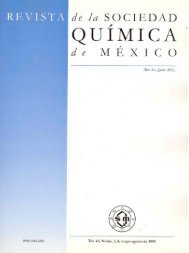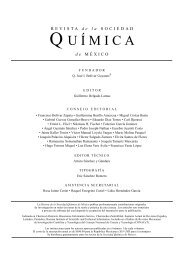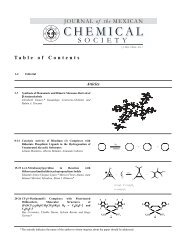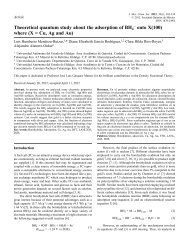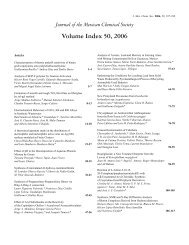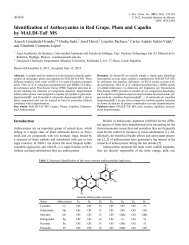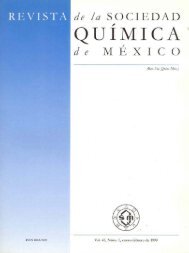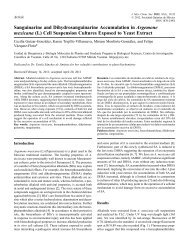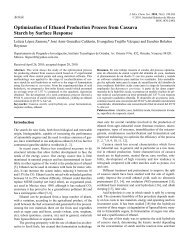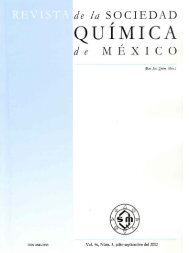SMQ-V047 N-002_ligas_size.pdf - Journal of the Mexican Chemical ...
SMQ-V047 N-002_ligas_size.pdf - Journal of the Mexican Chemical ...
SMQ-V047 N-002_ligas_size.pdf - Journal of the Mexican Chemical ...
You also want an ePaper? Increase the reach of your titles
YUMPU automatically turns print PDFs into web optimized ePapers that Google loves.
Preparation <strong>of</strong> 11-Hydroxylated 11,13-Dihydrosesquiterpene Lactones 133<br />
Table 1. Selected 1 H NMR data a .<br />
Sesquiterpene lactone CH 3 -13 H-6<br />
Dihydropar<strong>the</strong>nolide (4) 1.26 (d) 3.80 (dd)<br />
11α-Hydroxyhydropar<strong>the</strong>nolide<br />
(5) 1.31 (s) 3.79 (dd)<br />
11β-Hydroxydihydropar<strong>the</strong>nolide<br />
(6) 1.39 (s) 4.12 (dd)<br />
a <strong>Chemical</strong> shifts in ppm, multiplicity in paren<strong>the</strong>sis,<br />
s = singlet, d = doublet.<br />
oxygen, dried over P 2 O 5 , was bubbled through <strong>the</strong> solution for<br />
about 20 minutes. The reaction was quenched by <strong>the</strong> addition<br />
<strong>of</strong> 3-4 mL <strong>of</strong> distilled water. The solution was <strong>the</strong>n carefully<br />
neutralized with 5 % HCl and extracted with diethyl e<strong>the</strong>r.<br />
Sesquiterpene lactones 1, 10, 15, 21, and 24 were reacted<br />
under similar conditions. The products were separated using<br />
silica gel column chromatography, preparative thin-layer<br />
chromatography, or reversed-phase HPLC.<br />
The 11-hydroxylactones were analyzed by application <strong>of</strong><br />
IR, 1 H and 13 C NMR, and MS methods. The IR spectra <strong>of</strong> <strong>the</strong><br />
OH O<br />
OO -<br />
-<br />
HO<br />
B<br />
HO<br />
O<br />
O<br />
O<br />
O<br />
CH 3<br />
O<br />
CH 3<br />
O -<br />
O<br />
CH 3<br />
O -<br />
CH 3<br />
LDA<br />
H 2 O<br />
CO 3<br />
2-<br />
O<br />
A<br />
O<br />
O<br />
o - Li +<br />
O 2<br />
CH 3<br />
O O -<br />
O<br />
1. H 2 O<br />
2. Neutralize<br />
Scheme 1. Proposed mechanism <strong>of</strong> lactone enolate oxidations.<br />
O<br />
CH 3<br />
OH<br />
derivatives clearly showed a broad absorption signal near<br />
3400 cm –1 due to <strong>the</strong> lactonic 11-hydroxyl group. The 1 H<br />
NMR data also indicated hydroxylation at C-11 by collapse to<br />
a methyl singlet <strong>of</strong> <strong>the</strong> dihydrolactone C-11-methyl doublets<br />
(C-13). The 1 H NMR data was also used to distinguish<br />
between <strong>the</strong> 11α- and 11β-hydroxy-derivatives. Due to <strong>the</strong><br />
through-space deshielding effect <strong>of</strong> <strong>the</strong> C-11β hydroxyl group,<br />
<strong>the</strong> chemical shift <strong>of</strong> <strong>the</strong> lactonic signal (H-6β) for all 11βhydroxy-derivatives<br />
had shifted downfield by approximately<br />
0.3-0.5ppm, when compared to <strong>the</strong> corresponding nonhydroxylated<br />
starting compounds. In contrast, <strong>the</strong> chemical<br />
shifts <strong>of</strong> <strong>the</strong> H-6β signals for all 11α-hydroxyderivatives<br />
remained about <strong>the</strong> same as those <strong>of</strong> <strong>the</strong> corresponding dihydroprecursors<br />
(Table 1). The total yield <strong>of</strong> <strong>the</strong> 11-hydroxylactones<br />
in <strong>the</strong>se reactions ranged from 13-47 % with no apparent<br />
trends in stereoselectivity (Table 2).<br />
Norsesquiterpene ketones 13, 14, 20, and 28 were obtained<br />
as minor products <strong>of</strong> <strong>the</strong> reactions <strong>of</strong> 4, 10, 15, and 24,<br />
respectively, and in some cases <strong>the</strong>y represented <strong>the</strong> only<br />
product. The IR spectra <strong>of</strong> <strong>the</strong>se compounds showed absorptions<br />
near 3400 cm –1 due to <strong>the</strong> C-6 hydroxyl group and<br />
ano<strong>the</strong>r at about 1710 cm –1 due to <strong>the</strong> C-11-ketone carbonyl<br />
stretch absorption. The 1 H NMR data also showed methyl singlets<br />
near 2.10-2.20 ppm, indicative <strong>of</strong> a methyl ketone. The<br />
13C NMR spectra <strong>of</strong> <strong>the</strong>se compounds indicated <strong>the</strong> presence<br />
<strong>of</strong> only 14-carbons. Based on <strong>the</strong> above data, structures 13,<br />
14, 20, and 28 were proposed. Table 3 summarizes <strong>the</strong> 13 C<br />
NMR assignments <strong>of</strong> compounds 1-16, 20, and 21.<br />
A possible mechanism for <strong>the</strong> formation <strong>of</strong> <strong>the</strong> norsesquiterpene<br />
ketones may involve <strong>the</strong> decarboxylation <strong>of</strong> a<br />
hydroperoxide anion intermediate (Scheme 1). Hydroperoxides<br />
have been reported as <strong>the</strong> major products in reactions <strong>of</strong><br />
ester enolates with t-BuOK instead <strong>of</strong> LDA [9]. The existence<br />
<strong>of</strong> lactonic hydroperoxide intermediates was supported by <strong>the</strong><br />
isolation <strong>of</strong> 18 and 27 from <strong>the</strong>ir respective product mixtures.<br />
The hydroperoxide intermediates (Scheme 1, A) are <strong>the</strong>n<br />
reduced to <strong>the</strong> alcohols, probably by <strong>the</strong> conjugate acid, diisopropylamine,<br />
generated from LDA during formation <strong>of</strong> <strong>the</strong><br />
enolate [10]. 1,2-Dioxetane formation could arise following<br />
hydrolysis <strong>of</strong> <strong>the</strong> hydroperoxide anion (Scheme 1, B). 1,2-<br />
dioxetanes have been observed to decompose cleanly to carbonyl<br />
compounds which would generate <strong>the</strong> decomposition<br />
products isolated [11].<br />
The respective 1,10-epoxyderivatives 8, 9, 10 and 12<br />
were obtained by stereo- and regiospecific epoxidations <strong>of</strong> <strong>the</strong><br />
1,10-double bond <strong>of</strong> <strong>the</strong> 11-hydroxy-derivatives 2, 3, 4, and 6<br />
with m-chloroperbenzoic acid (m-CPBA) in <strong>the</strong> presence <strong>of</strong><br />
sodium acetate as a buffer to prevent fur<strong>the</strong>r cyclizations [12].<br />
Scheme 2




